German Fire Protection Police Officer's Service Tunic
CATEGORY: Version
SKU: 52.GOR.02.01.01.02.005.000
Estimated market value:
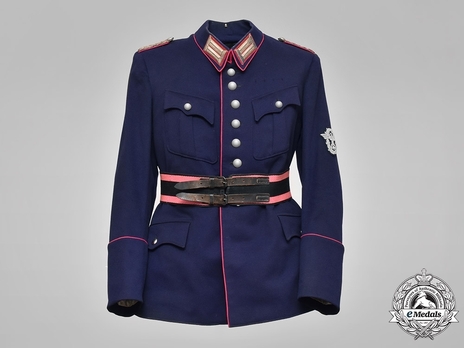
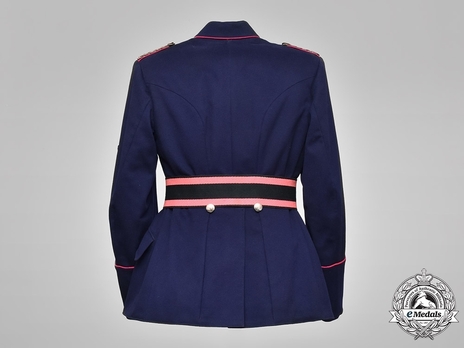
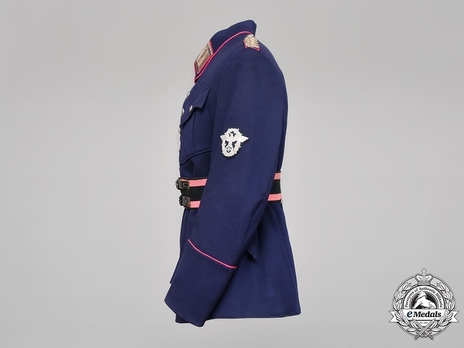
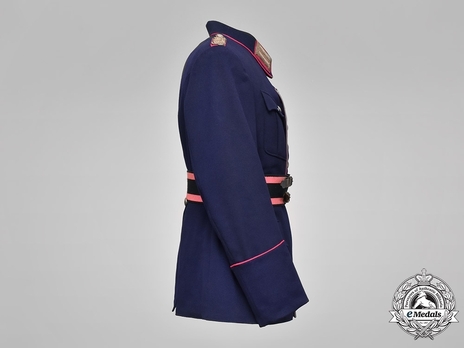
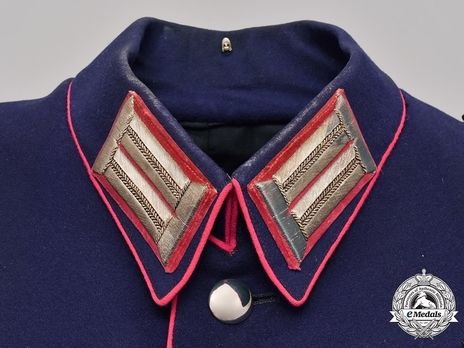
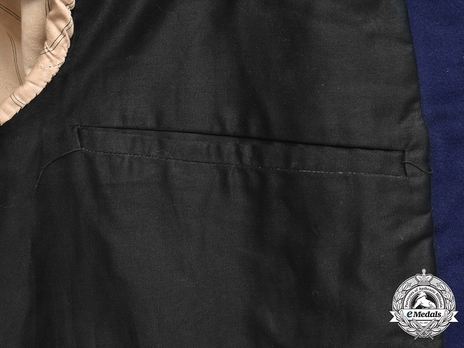
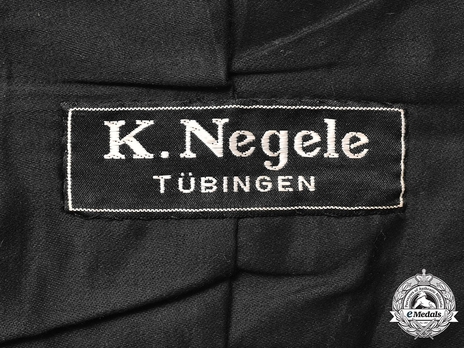
Estimated market value:
This is a well-preserved Feuerschutzpolizei uniform, the tunic is constructed of a fine quality dark blue wool with a black rayon-blended interior lining, the breasts of the tunic close by eight reinforced button holes meeting an equal number of pebbled, silver-coloured metallic buttons, the front exterior contains four pockets, all with reinforced button holes and equal number of pebbled buttons, the collar, constructed of dark-blue wool, is neatly lined with carmine coloured piping that continues down the length of the breast flaps, the inside right collar has two metal hooks meeting an equal number of metal loops on the left allowing the collar to sit flush with the neck, the collar is flanked on each side by tabs composed of carmine-coloured wool base bearing silver/aluminum wire Doppellitzen hand-embroidered into the badge cloth over a buckram backing, measuring 42 mm (w) x 71 mm (h), shoulder boards rest on each shoulder, constructed of two interwoven aluminum braids with five bends and a button loop, over pebbled buttons on a carmine-coloured wool backer indicating Major of the Feuerschutzpolizei, measuring 36 mm (w) x 100 mm (h), the left upper arm bears a sleeve insignia in the form of a police-style German national eagle clutching a wreathed mobile swastika machine-embroidered in silver aluminum bullion wire, within a larger oval wreath, all sewn onto a dark blue backing, measuring 86 mm (w) x 79 mm (h), both cuffs are turned up approximately 56 mm, held up by two pieces of stitching and outlined in carmine-coloured piping, striped off-white rayon-blended material lines the interior of the sleeves, the interior of the tunic contains a pocket on the upper left breast and a manufacturer's label for K. NEGELE, TÜBINGEN, accompanied by belt in woven black and carmine material, with two leather straps meeting two metal buckles, the reverse presents a central vertical vent measuring 27 cm in length, the tunic measures approximately 44 cm across the shoulders, 63 cm in the arms, with an overall length of 76 cm, presenting mild soiling over the exterior, in otherwise better than extremely fine condition.
During the Third Reich, an effort was made to unite all of Germany’s disparate provincial police forces and agencies into a single cohesive national unit. To attain this goal, Reichsführer-SS Heinrich Himmler was named Chief of the German Police in the Ministry of the Interior in June 1936. That same month, Himmler implemented new standardized uniforms, headgear, and insignia. The uniforms worn prior to Himmler’s appointment were often navy blue, particularly in what had been Prussia. The new uniforms were green, in a shade that was then dubbed “Police green”.
The German Police were divided into two main units, the Ordnungspolizei (Orps or Regular Police) and the Sicherheitspolizei (Secret Police); the Ordnungspolizei were unofficially called the green police (Grüne Polizei) as a result of their uniform colour. The Sicherheitspolizei were made up of two main organizations, the Gestapo and the Kriminalpolizei (Criminal Investigation Police). At the beginning of the Second World War, the Sicherheitspolizei were brought under the auspices of the Reich Main Security Office.
The Ordnungspolizei was also divided into smaller branches of service, and each branch was associated with a branch of service/troop colour (Truppenfarbe). The troop colours include:
Schutzpolizei des Reichs (National Protection Police): Green
Schutzpolizei der Gemeinden (Municipal Police) pre-1942: Red
Schutzpolizei der Gemeinden (Municipal Police) post-1942: Green
Gendarmerie (Gendarmes/Rural Police): Orange
Verwaltungspolizei (Administrative Personnel) pre-1942: Red over grey
Verwaltungspolizei (Administrative Personnel) post-1942: Light grey
Feuerschutzpolizei (Fire Protection Police): Carmine
Wasserschutzpolizei (Water Protection Police): Yellow
The uniform garments worn by members of the Wasserschutzpolizei (Water Protection Police) and the Feuerschutzpolizei (Fire Protection Police) remained blue after the 1936 uniform redesign.
The service tunics were worn by all ranks of German police personnel.
The buttons are silver-coloured (aluminum) and pebbled, with the exception of General ranks who wore gold-coloured buttons. There are generally eight buttons on the front closure (Generals only had six), two buttons on each sleeve cuff, and one button closing each pocket. There may also be four decorative buttons on the tunic's reverse vent. The vent is also lined in Truppenfarbe piping.
There are four exterior pockets in total on the tunic, with two at breast level and two at hip level. The pockets are generally “patch” pockets with scalloped flaps closed by one button each.
The collar and sleeve cuffs have an additional layer of brown wool, and for Officers and Non-Commissioned Officers/Enlisted Men (NCOs/EMs) they are lined in Truppenfarbe piping, same as the seam of the front closure.
The tunic may be lined with rayon, cotton, artificial silk, or silk, depending on the wearer's rank, as well as whether the tunic was manufactured privately. There are often interior pockets cut into the tunic's lining, and a manufacturer's label is often ink stamped or sewn onto tunic lining.
The insignia featured on these tunics include collar tabs, shoulder boards, and a sleeve eagle. See the relevant Insignia sections for more information.

Comments
Sign in to comment and reply.


Scroll Top